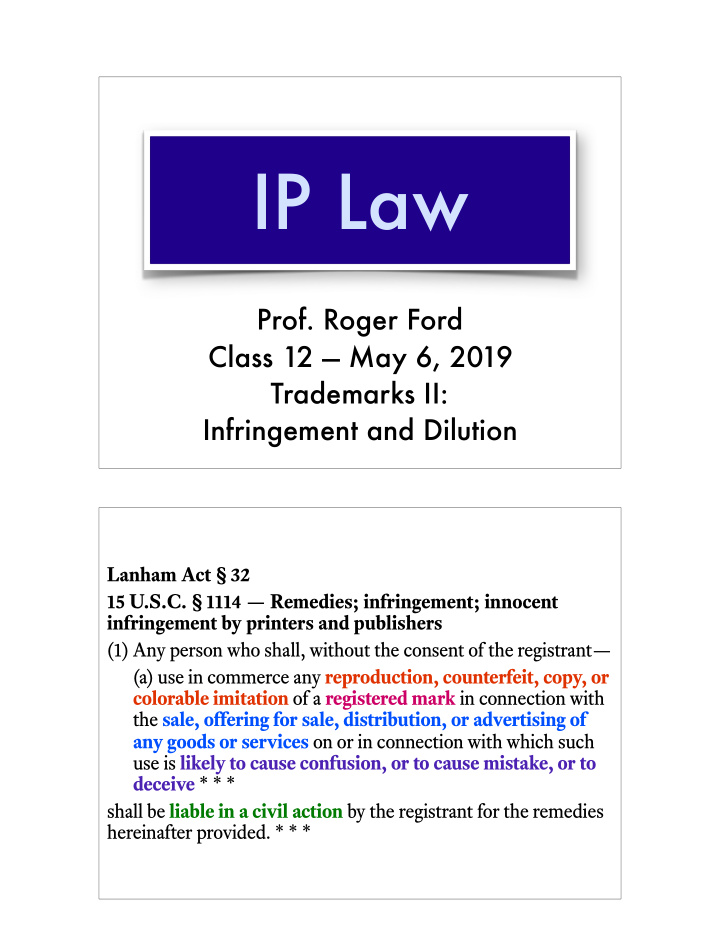



IP Law Prof. Roger Ford Class 12 — May 6, 2019 Trademarks II: Infringement and Dilution Lanham Act § 32 15 U.S.C. § 1114 — Remedies; infringement; innocent infringement by printers and publishers (1) Any person who shall, without the consent of the registrant— (a) use in commerce any reproduction, counterfeit, copy, or colorable imitation of a registered mark in connection with the sale, offering for sale, distribution, or advertising of any goods or services on or in connection with which such use is likely to cause confusion, or to cause mistake, or to deceive * * * shall be liable in a civil action by the registrant for the remedies hereinafter provided. * * *
Lanham Act § 43 15 U.S.C. § 1125 — False designations of origin, false descriptions, and dilution forbidden (a) Civil action (1) Any person who, on or in connection with any goods or services , or any container for goods, uses in commerce any word, term, name, symbol, or device, or any combination thereof , or any false designation of origin, false or misleading description of fact, or false or misleading representation of fact , which— (A) is likely to cause confusion , or to cause mistake , or to deceive as to the affiliation, connection, or association of such person with another person, or as to the origin, sponsorship, or approval of his or her goods, services, or commercial activities by another person, or (B) in commercial advertising or promotion, misrepresents the nature, characteristics, qualities, or geographic origin of his or her or another person’s goods, services, or commercial activities, shall be liable in a civil action by any person who believes that he or she is or is likely to be damaged by such act. * * * Lanham Act § 43 15 U.S.C. § 1125 — False designations of origin, false descriptions, and dilution forbidden (c) Dilution by blurring; dilution by tarnishment (1) Injunctive relief Subject to the principles of equity, the owner of a famous mark that is distinctive, inherently or through acquired distinctiveness , shall be entitled to an injunction against another person who, at any time after the owner’s mark has become famous, commences use of a mark or trade name in commerce that is likely to cause dilution by blurring or dilution by tarnishment of the famous mark, regardless of the presence or absence of actual or likely confusion, of competition, or of actual economic injury. * * *
Lanham Act § 43 15 U.S.C. § 1125 — False designations of origin, false descriptions, and dilution forbidden * * * (B) For purposes of paragraph (1), “ dilution by blurring ” is association arising from the similarity between a mark or trade name and a famous mark that impairs the distinctiveness of the famous mark . In determining whether a mark or trade name is likely to cause dilution by blurring, the court may consider all relevant factors, * * * (C) For purposes of paragraph (1), “ dilution by tarnishment ” is association arising from the similarity between a mark or trade name and a famous mark that harms the reputation of the famous mark . * * *
(pre-AIA) 35 U.S.C. § 102 — Conditions for patentability; novelty and loss of right to patent A person shall be entitled to a patent unless — (a) the invention was known or used by others in this country , or patented or described in a printed publication in this or a foreign country, before the invention thereof by the applicant for patent, or (b) the invention was patented or described in a printed publication in this or a foreign country or in public use or on sale in this country , more than one year prior to the date of the application for patent in the United States, or * * *
Recommend
More recommend